Lesser Sand Plover Charadrius mongolus 蒙古沙鴴
Category I. Common passage migrant in spring and autumn, more numerous in spring; counts have decreased substantially since the 1990s. Scarce winter visitor. Occurs mainly on intertidal mudflats in Deep Bay.
IDENTIFICATION
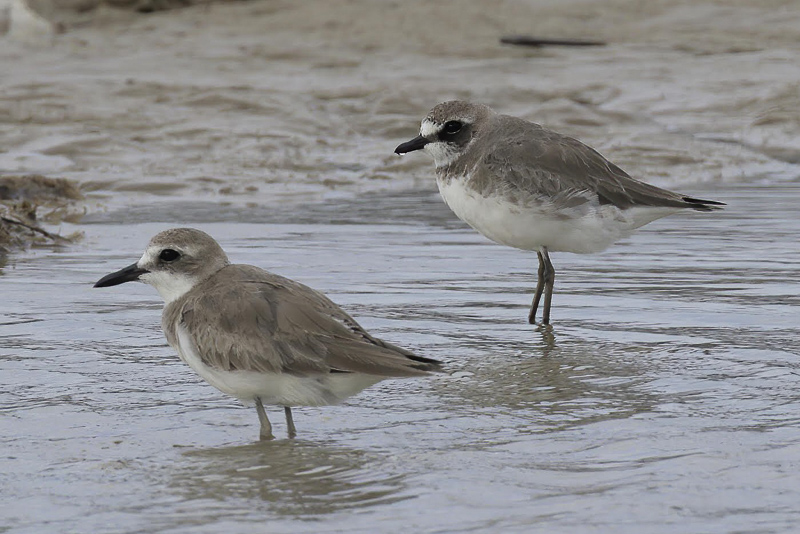
Apr. 2021, Sarawak, Malaysia. Dave Bakewell. Greater Sand Plover (left) and Lesser Sand Plover mongolus group (right).
Independent of plumage and taxon, distinguished from Greater Sand Plover in the following ways. Firstly, by structure: Lesser Sand Plover is smaller with neater proportions, less deeply-based bill that has a less swollen distal half and stubbier tip, a smaller eye and shorter legs. Secondly, most birds have greyish legs and darker upperparts (especially in spring). Finally, foraging behaviour also different: Lesser Sand Plover has a more regular ‘stop-start’ foraging motion.
Lesser Sand Plovers are divided into two groups (mongolus or ‘Siberian Sand Plover’ and atrifrons or ‘Tibetan Sand Plover’) which are generally identifiable in the field and may refer to separate species. For more detail on their separation readers are referred to Bakewell (2022), which has been the key reference in preparing this section.

Oct. 2020, Sarawak, Malaysia. Dave Bakewell. Lesser Sand Plovers: mongolus group (left), atrifrons group (right).
Separation of the mongolus and atrifrons groups in non-breeding plumage is not straightforward. In general, mongolus has colder and darker brown upperparts and ear coverts (making the white forehead and throat more obvious), greyish mottling on the flanks (although this may be faint), more extensive breast patches that often meet in the centre, a thicker stubbier bill, a slightly bulkier and less elegant body and shorter more olive legs.
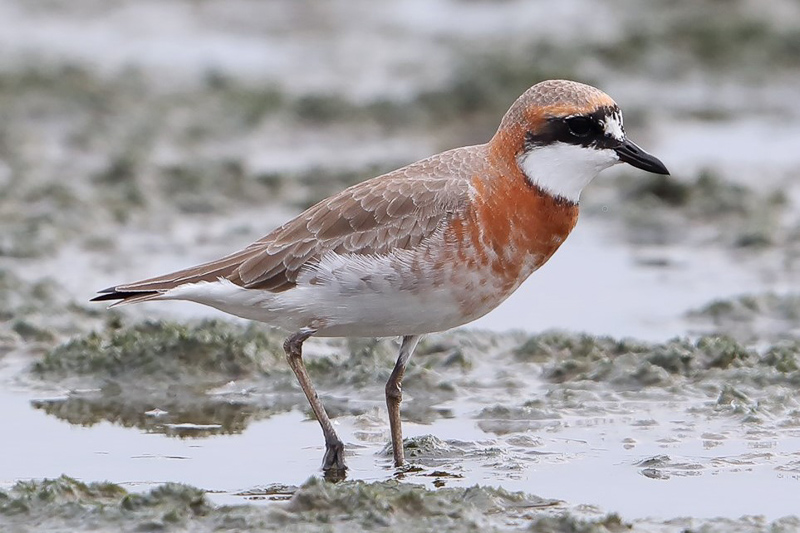
Apr. 2018, Michelle and Peter Wong. Male of mongolus group, breeding plumage.
18-21 cm. In breeding plumage males of the mongolus group have extensive cinnamon across the breast, usually with a narrow blackish border below the throat; the mid to lower flanks have irregular dull cinnamon or greyish mottling, and this may extend down to the sides of the vent. The upperparts are fairly dark and cold grey-brown, and the forehead is extensively white. Females have a narrower and more broken breast band, and browner ear coverts.
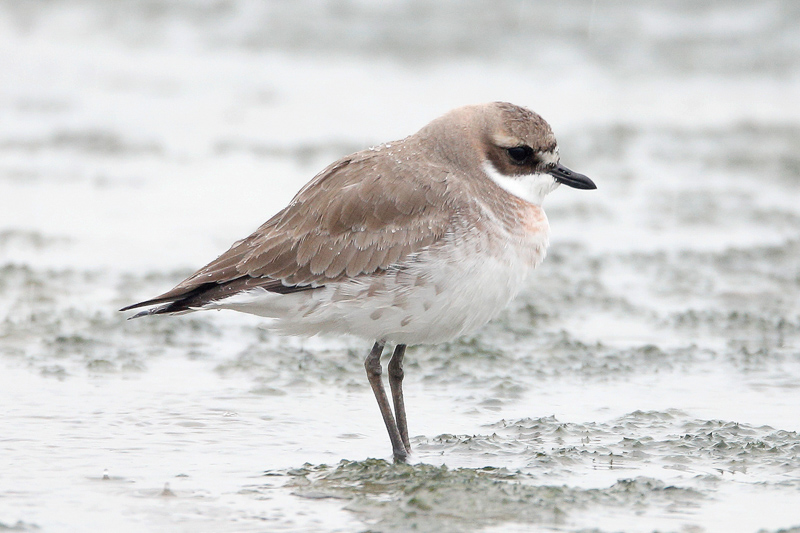
May 2013, Martin Hale. Probably second calendar-year female of the mongolus group.
This bird has only just begun moult from non-breeding to breeding plumage, with only new scapulars and pale cinnamon feathers appearing on chest and nape. The dark ear coverts, flank markings, pale forehead and bill structure indicate it is of the mongolus group.
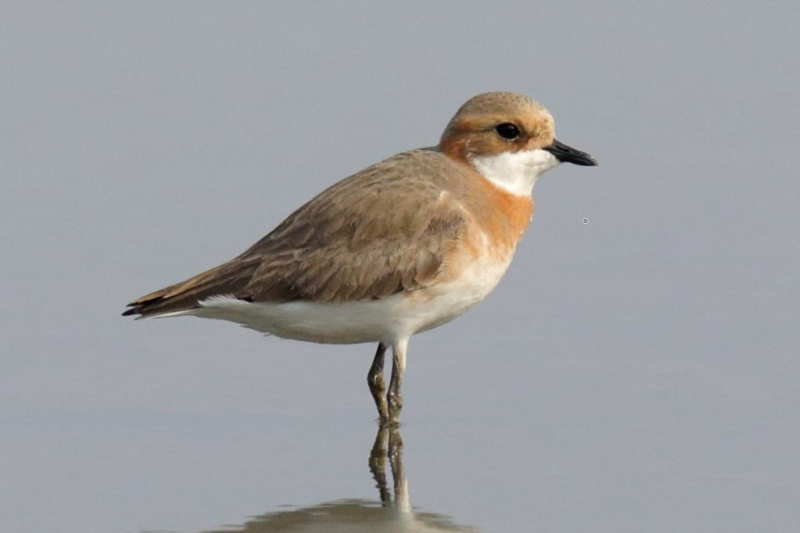
Apr. 2014, John and Jemi Holmes. Female atrifrons group, breeding plumage.
Breeding plumage adults of the atrifrons group are paler, more orange on the chest, have clean white flanks and, on males, a more extensively dark forehead. Females, as this appears to be, are paler on the chest (orange-buff replacing the cinnamon) and have ear coverts not noticeably darker than crown.
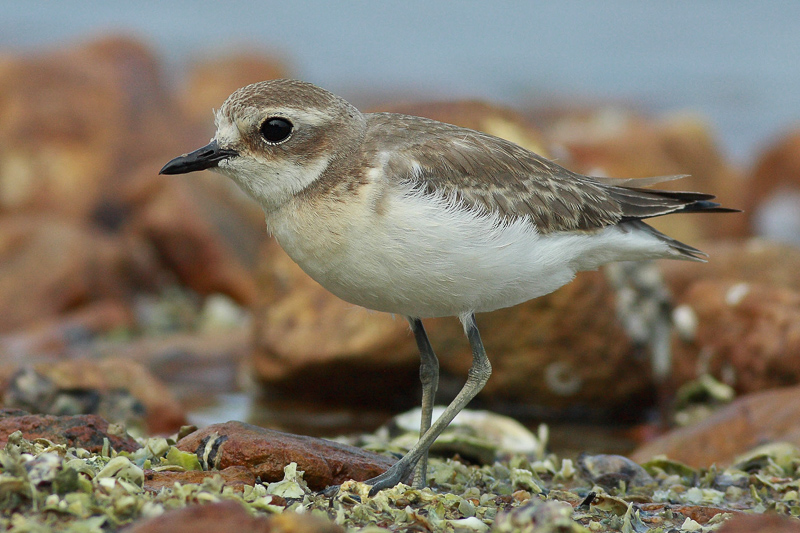
Oct. 2008, Fung Hon Shing. First-year atrifrons group.
This first-calendar year bird of the atrifrons group has a pale forehead that blends into the brown crown, warmer coloured fringes to the coverts and scapulars, cleaner flanks, more buff on the underparts, smaller breast patches that do not meet in the centre and relatively longer legs and bill.

Oct. 2010, Vivian Cheung. First-year, mongolus group.
The more obvious white forehead and throat, greyish mottling on the flanks, more extensive breast patches meeting in the centre and the thicker stubbier bill are visible on this bird of the mongolus group.
VOCALISATIONS
The typical flight call is a trilling note that is very similar to Greater Sand Plover, though occasionally it sounds slightly drier; care and experience is required to separate the two.
DISTRIBUTION AND HABITAT PREFERENCE
Most records are from the intertidal mudflats of Deep Bay, adjacent roosting areas of Mai Po NR and, occasionally, drained commercial fish ponds. It is also recorded on intertidal mudflats off Lantau (primarily Shui Hau), Sha Tau Kok and inner Tolo Harbour at Ting Kok, and is occasionally seen on outlying islands such as Po Toi. There are also records from the former airport at Kai Tak, where up to 18 were recorded, and the current airport at Chek Lap Kok (maximum three).
OCCURRENCE
Systematic shorebird counts since 1998 indicate that Lesser Sand Plover is mainly a passage migrant in both spring and autumn, with numbers substantially higher in the former (Figure 1). Spring migration appears to commence early March, with main passage occurring in the last three weeks of April and the first week of May, peaking in the second half of April. Passage usually peters out in the first week of June, and for the rest of the month until near the end of July only single figure counts are generally made.
The highest spring counts are 500 on 14 April 1991 and 300 on 30 April 1983. This century however, the highest counts are lower at 281 on 12 April 2020 and 200 on 24 April 2003.
Autumn passage commences by at least the final week of July but is rather desultory. Numbers are highest in the period up to the middle of August, but counts are usually only ten birds or fewer, which compares with the comment in Carey et al. (2001) that autumn counts were generally 100 or fewer. The highest autumn count this century is 65 on 14 October 2018, with the next highest being 28. These are in contrast to the highest autumn counts on record, which are 255 on 15 November 1992 and 200 on 12 October 1991.
Up to 150 birds were recorded in Deep Bay during the winter in the 1990s, though the number present was rather variable with as few as five birds recorded in some winter periods. Since then, the highest count is 30 on 13 December 2020.
Since the early 1990s there appears to have been a decline in the number of Lesser Sand Plovers on both spring and, especially, autumn passage, with both peak and typical counts decreasing; in addition, counts in midwinter have also declined. Figure 2 illustrates the pattern of peak counts of migrants since 1998.
With regard to subspecies, it is clear that birds in the atrifrons group (‘Tibetan Sand Plover’) are rather scarce in spring, when birds in the mongolus group (‘Siberian Sand Plover’) dominate. The situation in autumn is unclear, while it appears most or all birds in winter are ‘Siberian Sand Plover.’
Vaughan and Jones (1913) referred to a species of sand plover as an accidental winter visitor, though it is not entirely clear which, as it was named ‘Great Sand-Plover Ochthodromus mongolus’. Dove and Goodhart (1955) stated that Lesser Sand Plover occurred on both passages but never in such numbers as Greater Sand Plover.
BEHAVIOUR, FORAGING & DIET
Unlike its congener Greater Sand Plover, Lesser Sand Plover does not favour crabs, instead targeting worms and other invertebrates. The foraging technique involves more constant movement over the mudflat, rather than the relatively long periods of waiting utilised by Greater Sand Plover.
RANGE & SYSTEMATICS
Five subspecies, which are usually divided into two groups, are recognised. The mongolus group ('Siberian Sand Plover'), which breeds in scattered areas of southeast and east Siberia from southern Chukotka and Kamchatka south to the Amur River floodplain, comprises the nominate form and C. m. stegmanni. The atrifrons group (‘Tibetan Sand Plover’), which breeds in high plateau areas north and east of the Himalayas as far as extreme southern Mongolia and west to the Pamirs, comprises C. m. pamirensis, C. m. atrifrons and C. m. schaeferi. Representatives of both groups pass through HK, though the majority appear to be part of the mongolus group.
In China breeds in plateau areas in the western half of the country, migrates through eastern coastal areas and the Chang Jiang (Yangtze River) floodplain and winters along the south coast, including Hainan and Taiwan (Liu and Chen 2020).
CONSERVATION STATUS
IUCN: Least Concern. Population trend unknown.
Figure 1.

Figure 2.
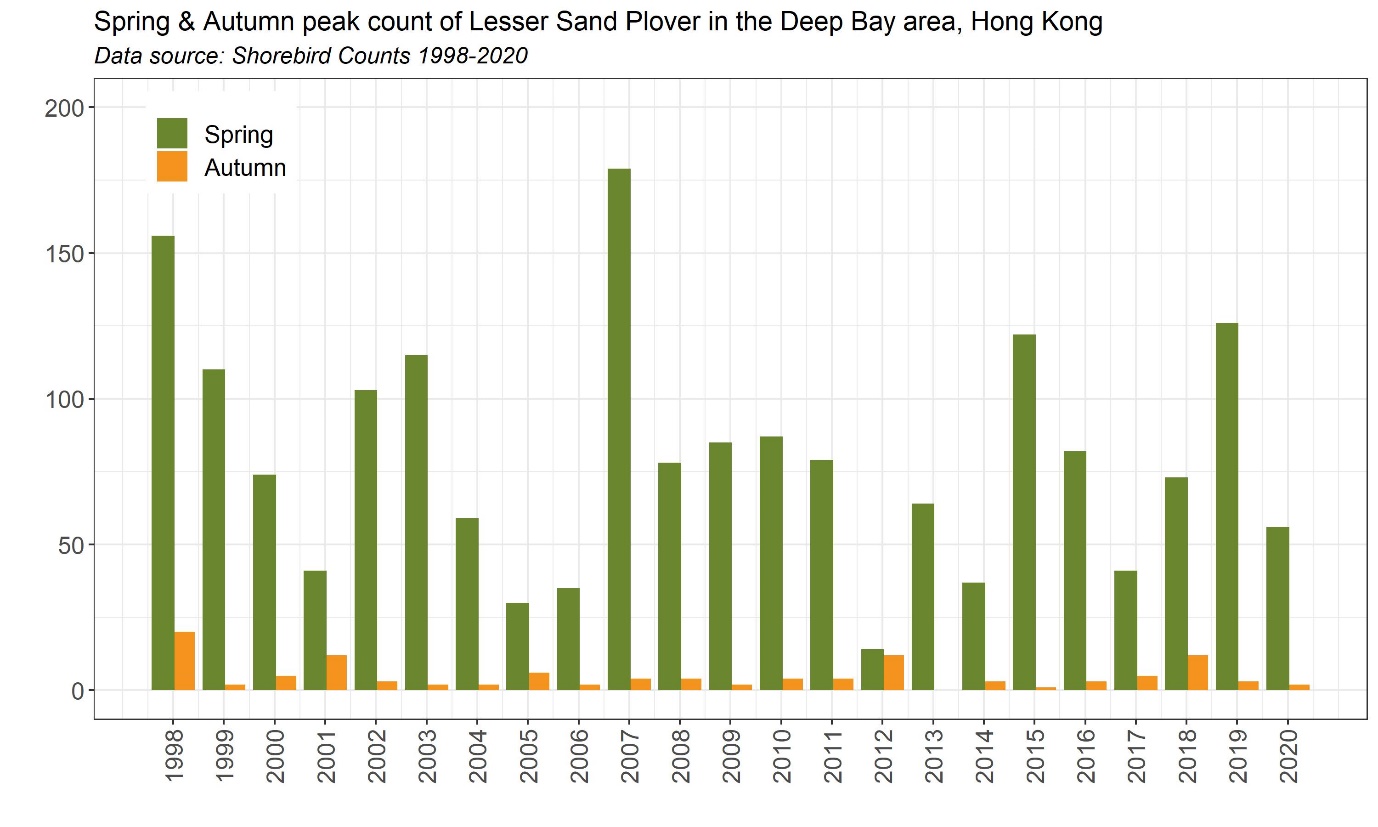
Bakewell, D. N. (2022). Identification of Siberian Charadrius (mongolus) mongolus and Tibetan C. (m.) atrifrons Sand Plovers. BirdingAsia 38 (2022): 23-36.
Dove, R. S. and H. J. Goodhart. (1955). Field observations from the Colony of Hong Kong. Ibis 97: 311-340.
Vaughan, R. E. and K. H. Jones. (1913). The birds of Hong Kong, Macao and the West River or Si Kiang in South-East China, with special reference to their nidification and seasonal movements. Ibis 1913: 17-76, 163-201, 351-384.
Liu, Y. and Y. H. Chen (eds) (2020). The CNG Field Guide to the Birds of China (in Chinese). Hunan Science and Technology Publication House, Changsha.

